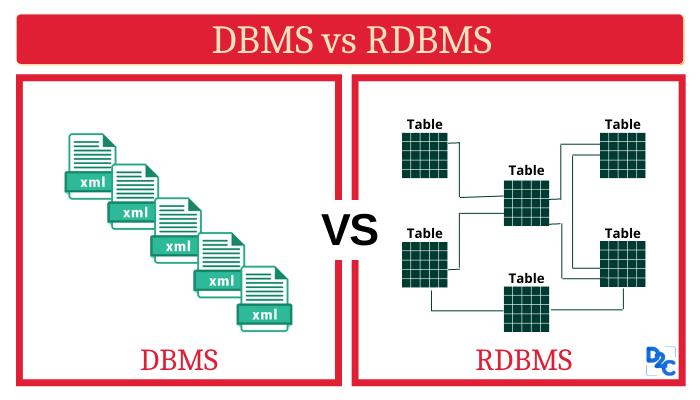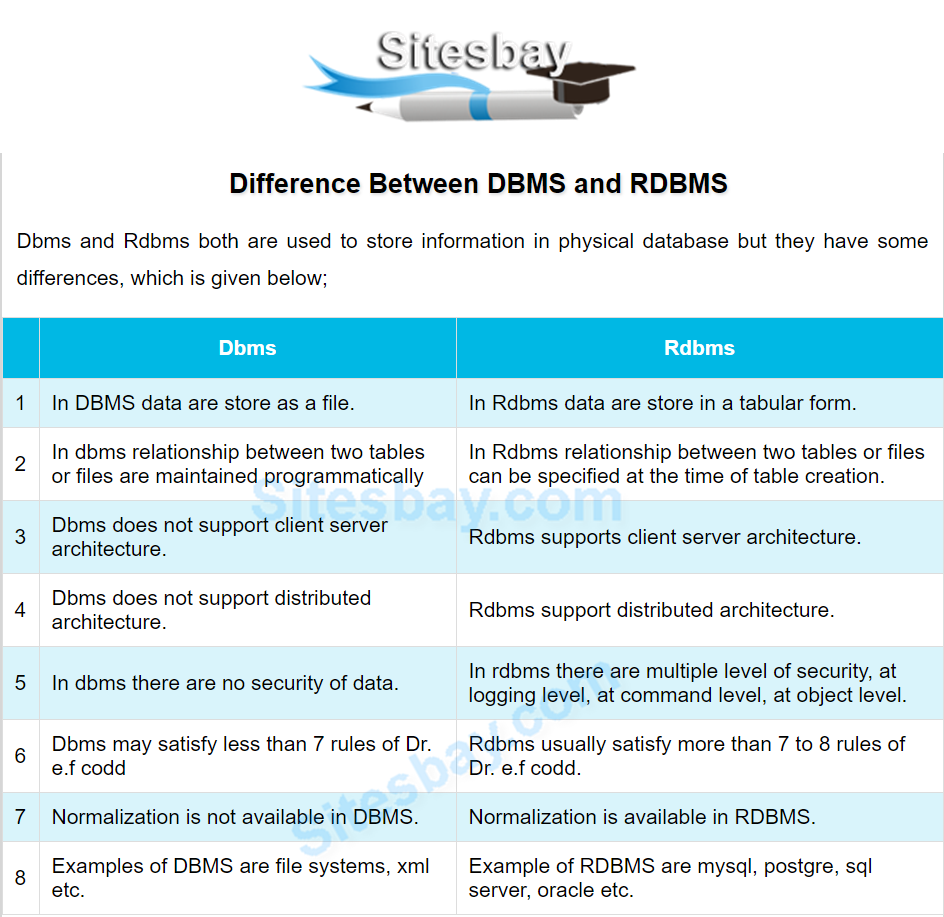Difference Between Dbms and Rdbms Explain With Example
Relationship among tables is maintained in a RDBMS whereas this not the case DBMS as it is used to manage the database. The key difference is that RDBMS relational database management system applications store data in a tabular form while DBMS applications store data as files.

Difference Between Dbms And Rdbms Why Rdbms Is An Advanced Version Of Dbms D2c
DBMS is an umbrella term for different types of database management technologies developed over the past 50-plus years.
. There can be but there will be no relation between the tables like in a RDBMS. 10 rows DBMS RDBMS. Most state-of-the-art research in databases is equipped towards supporting.
- DBMS does not follow normalization. Till date no RDBMS satisfies all the 12 rules. RDBMS is designed to handle large amount of data.
4Suitable to store a small amount of data. DBMS can be used for simple applications whereas its next generation design ie. The below table demonstrates the main difference between RDBMS and DBMS.
6There is high data redundancy. Key Difference between DBMS and RDBMS. Data is stored in small quantity.
Only single user can access the data. A relational database management system RDBMS is. Every value stored in the relational database is accessible.
- ACID properties of database must be implemented by the user or the developer 2 RDBMS. It stands for Database Management System. Individual data values can be accessed.
1 DBMS applications store data as file. DBMS is meant to be for small organization and deal with small data. Examples of DBMS are file systems xml etc.
Data elements need to access. RDBMS can be used for complex business applications. - It has additional condition for supporting tabular structure or data that enforces relationships among tables.
The main difference between a DBMS and an RDBMS is DBMS stores data as files while RDBMS stores data in tabular form. RDBMS support distributed database. Advanced database management systems likewise support recent fads or you can say trends in data management filled by application needs for example support for advanced investigation stream handling systems and fundamental memory information handling.
DBMS does not support distributed database. It extends for Relational. DBMS is software for managing the database.
- DBMS does not impose integrity constraints. In transaction processing or BI and analytics applications. Difference between SQL and PLSQL.
RDBMS examples are Oracle MySQL SQL Server and so on. Does that mean there are no tables in a DBMS. DBMS stands for DataBase Management System.
Normalization is not present in RDBMS. IBMs Information Management System IMS is an example of DBMS and Microsoft SQL Server is an example of RDBMS. Multiple data elements can be accessed together.
Suitable to store a large amount of data. For a DBMS to be termed as RDBMS it must satisfy atleast 6-7 rules out of the 12 rules defined by EF Codd. 14 rows DBMS stores data as file.
Difference Between DBMS and RDBMS is that DBMS stores data in files but RDBMS stores data in. The file system is software that manages and organizes the files in a storage medium within a computer. It supports single user.
We can declare that an RDBMS the full form is Relational Database Management System is an. 12 rows Difference between DBMS and RDBMS. To notice the difference between DBMS and RDBMS the DBMS stores data in a file format with a hierarchical or navigational.
RDBMS can be thought of as an extension of DBMS inspite of the differences between them. 3RDBMS define the integrity constraint for the purpose of ACID Atomocity comnsistency Isolation and Durability property. RDBMS stands for.
Data is stored in relationstable format. - RDBMS stores the data in tabular form. Example of RDBMS are mysql postgre sql server oracle etc.
DBMS vs RDBMS Data in DBMS while stores do not follow ACID model atomicity consistency isolation durability and create inconsistencies in database while RDBMS uses ACID model to manage database and therefore it is well. Every RDBMS is a DBMS but the opposite is not true. Storage and database structure.
In DBMS there is no redundant data. DBMS examples are XML file systems Windows Registry etc. Data is stored in file format.
DBMS is used for simpler business applications whereas. DBMS accepts the flat file data that means there is no relation among different data whereas RDBMS does not accepts this type of design. A database management system is software that supports the development administration and use of databases.
RDBMS stores data in tabular form. Redundant data can be present in a file system. Normalization of data helps in removing data repetition and redundancy.
The relationships between these data values will be stored in the form of a table as well. DBMS is a software to determine create and preserve a. The key difference is that RDBMS relational database management system applications store data in a tabular form while DBMS applications store data as files.
Here is the basic difference between DBMS and RDBMS with example.
What Is The Difference Between Dbms And Rdbms Pediaa Com


No comments for "Difference Between Dbms and Rdbms Explain With Example"
Post a Comment